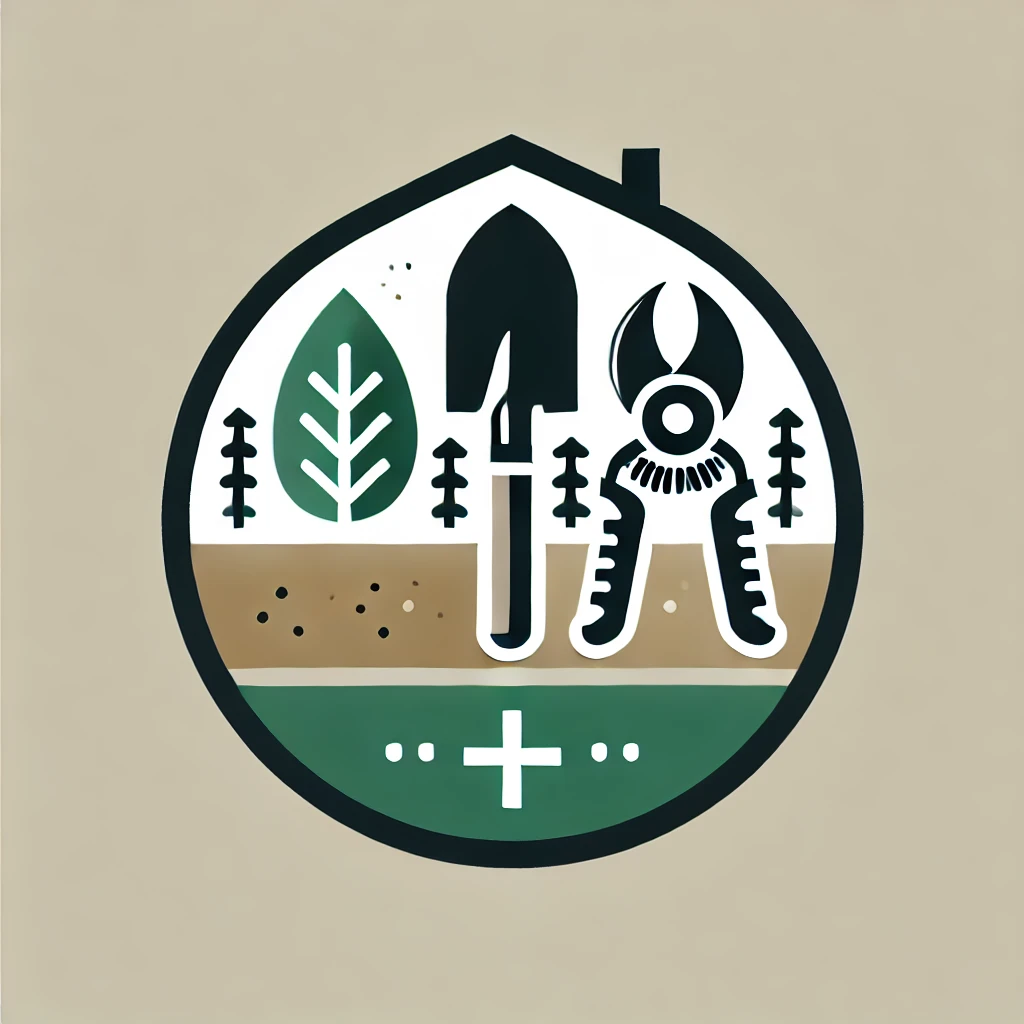Have you ever wondered how urban gardeners manage to create thriving green spaces in the most unlikely places? You're about to discover one of their best-kept secrets: the DIY hanging shoe organizer garden.
This ingenious approach to vertical gardening takes a humble closet staple and transforms it into a thriving, productive green space. Each pocket becomes a miniature planter where you can grow herbs, flowers, or compact vegetables. It's a space-saving solution that revolutionizes urban gardening.
The beauty of this method lies in its accessibility. You don't need a sprawling backyard or expensive equipment. All you need is a shoe organizer, some soil, and a dash of creativity. It's perfect if you're an apartment dweller, have limited outdoor space, or simply want to add a touch of green to your living area.
Don't underestimate what you can accomplish with a well-planned shoe organizer garden. These setups can provide you with fresh herbs and salad greens year-round, all from a single door or wall space. It's a testament to the untapped potential of your living spaces.
In this guide, we'll walk you through everything from selecting the right organizer and plants to maintaining your vertical oasis. Whether you're a seasoned gardener looking for a new challenge or a complete novice eager to grow your first plant, this guide will help you transform your space and potentially even your relationship with food.
Choosing Your Organizer
The foundation of your hanging garden is the shoe organizer itself. While you might be tempted to use whatever you have lying around, putting some thought into this choice can make a significant difference.
Material Matters
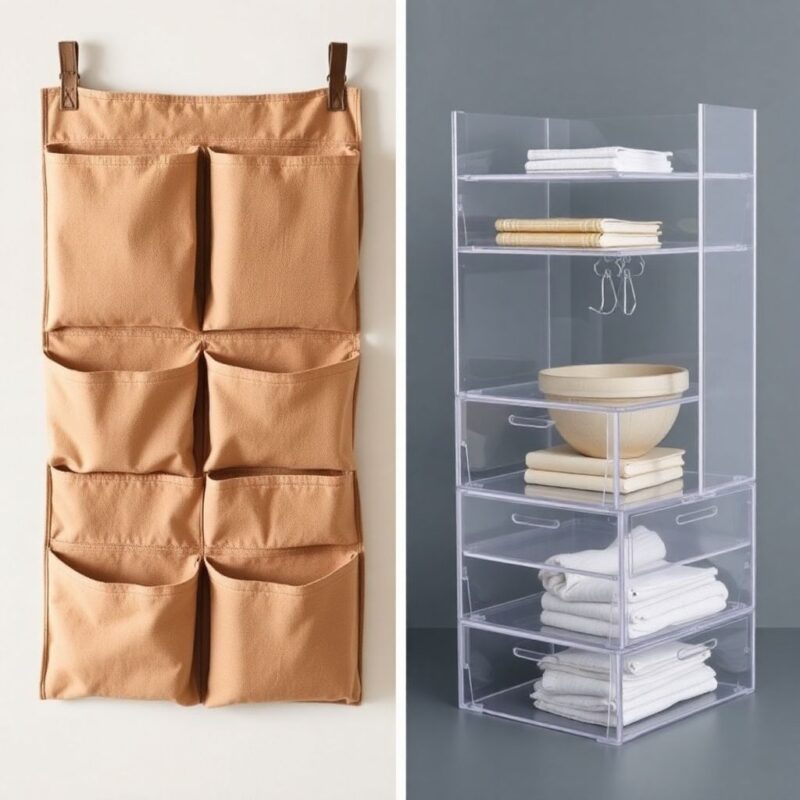
Canvas or fabric organizers are popular choices because of their breathability, which promotes root health. However, they can be prone to mold if you overwater them. Plastic organizers, on the other hand, are more durable and easier to clean, but you may need to add extra drainage holes.
Size Considerations
A standard over-the-door organizer typically has 24 pockets, giving you plenty of planting space. But if you're working with a smaller area or just starting out, a compact 12-pocket version can be a great option.
Pro Tip: Look for organizers with clear pockets. They might not be as aesthetically pleasing initially, but they allow you to monitor soil moisture levels and root health more easily.
Preparing Your Organizer
Once you've selected your organizer, it's time to prep it for its new life as a garden. This step is crucial for the long-term health of your plants.
Reinforcing the Structure
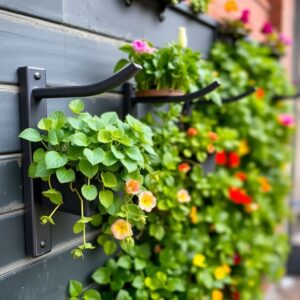
Start by reinforcing the hanging mechanisms. Once you fill it with soil and plants, your organizer will be significantly heavier. Use strong hooks or brackets to ensure your garden stays securely in place.
Ensuring Proper Drainage
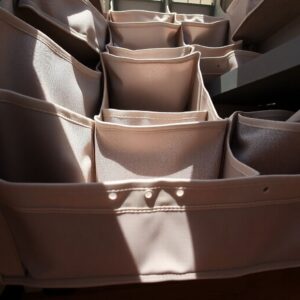
Good drainage is essential to prevent waterlogging and root rot. For fabric organizers, you can usually get away with poking a few small holes in the bottom of each pocket. For plastic ones, you'll want to drill or cut more substantial drainage holes.
Lining the Pockets
Consider lining each pocket with landscape fabric or coconut coir. This helps retain soil while allowing water to pass through. It also extends the life of your organizer by preventing soil from constantly being in direct contact with the material.
Choosing Your Plants
Now comes the exciting part – deciding what to grow! You have nearly endless options, but it's important to choose plants that are well-suited to the unique environment of a hanging garden.
Herbs: A Great Starting Point
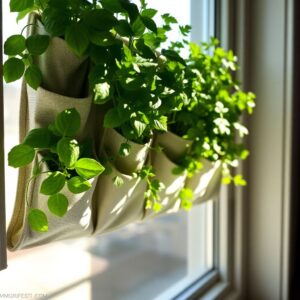
Herbs are fantastic if you're a beginner. They're generally low-maintenance, fast-growing, and incredibly useful in the kitchen. Some excellent options include:
- Basil
- Mint
- Thyme
- Cilantro
- Oregano
- Chives
Compact Vegetables
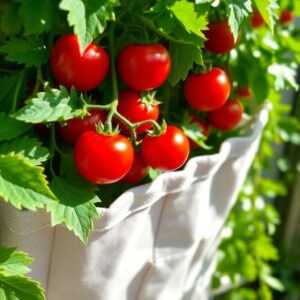
If you're feeling more adventurous, try some compact vegetables. These can thrive in your shoe organizer setup:
- Cherry tomatoes
- Dwarf peas
- Small pepper varieties
- Leafy greens like lettuce or spinach
Place these heavier feeders in the top rows where they'll have more soil depth.
Adding Color with Flowers
For a pop of color, consider adding some flowers. Not only do they look great, but they can also help attract pollinators if your garden is outdoors. Some good choices include:
- Pansies
- Petunias
- Marigolds
- Nasturtiums (which are also edible!)
Light Considerations
Remember to consider the light conditions of your space when selecting plants. A sunny balcony will support a different range of plants than a partially shaded indoor wall. Research the light requirements of your chosen plants and group them accordingly.
Planting Your Garden
With your organizer prepped and plants selected, it's time to bring your vertical garden to life.
Soil Selection
Start by filling each pocket about two-thirds full with a high-quality, lightweight potting mix. Avoid using garden soil, as it's too heavy and doesn't drain well enough for container gardening. Look for mixes specifically formulated for container plants, as these often include perlite or vermiculite for improved drainage and aeration.
Planting Technique
When planting, gently loosen the root ball of your plants and position them in the center of each pocket. Add more soil around the roots, pressing gently to eliminate air pockets. Leave about an inch of space at the top of each pocket for watering.
Pro Tip: Plant densely! In a vertical garden, you can place plants closer together than you would in a traditional garden. This creates a lush, full look and maximizes your growing space.
Companion Planting
Consider companion planting principles when arranging your plants. Some plants grow better together, while others may hinder each other's growth. For example, basil and tomatoes are great companions, as are marigolds and most vegetables (they help repel pests).
Watering and Maintenance
Proper watering is perhaps the biggest challenge you'll face in maintaining a shoe organizer garden. The confined space of each pocket means soil can dry out quickly, especially for pockets near the top.
Watering Techniques
A small watering can with a narrow spout works best for targeting individual pockets. Water slowly and thoroughly, ensuring that excess water drains out the bottom. In hot weather, you might need to water daily.
For a more hands-off approach, consider setting up a simple drip irrigation system. This can be as basic as a series of small tubes running from a reservoir at the top of your garden.
Fertilizing
Fertilizing is crucial in this intensive growing system. Use a balanced, water-soluble fertilizer every two weeks during the growing season. Alternatively, you can mix slow-release fertilizer pellets into your potting mix at planting time.
Pruning and Harvesting
Regular pruning and harvesting will keep your plants healthy and productive. Don't be shy about snipping herbs or pinching off flowers – most plants will respond with increased growth. For herbs, harvest the outer leaves first, allowing the center to continue growing.
Troubleshooting Common Issues
Even with the best care, you might encounter some challenges with your shoe organizer garden. Here are some common issues and how to address them:
1. Uneven Growth
If plants in some pockets are thriving while others struggle, it's likely due to uneven water distribution. Try rotating your organizer periodically or adjusting your watering technique. You might also need to relocate plants that aren't thriving in their current position.
2. Pest Infestations
The close proximity of plants can make pest control tricky. Inspect your plants regularly and treat issues promptly. Neem oil is a great organic option for many common pests. For flying insects, sticky traps can be effective. If you're growing outdoors, encourage beneficial insects like ladybugs and lacewings to help control pests naturally.
3. Mold or Mildew
This is often a sign of overwatering or poor air circulation. Increase airflow around your garden by using a small fan or opening nearby windows. Adjust your watering habits, allowing the soil surface to dry slightly between waterings. If mold persists, you may need to remove affected plants and replace the soil.
4. Nutrient Deficiencies
Yellow leaves or stunted growth could indicate a lack of nutrients. Increase the frequency of fertilization or switch to a higher-quality fertilizer. Different plants have different nutrient needs, so research the specific requirements of your plants. Consider using a foliar spray for quick nutrient uptake in severe cases.
5. Root Binding
Over time, vigorous plants may outgrow their pockets. Don't hesitate to transplant these to larger containers and replace them with new plants. This is a great opportunity to refresh your garden and try new varieties.
Expanding Your Vertical Garden
Once you've mastered the basics of shoe organizer gardening, there are countless ways you can expand and enhance your setup. Here are some ideas to take your vertical garden to the next level:
1. Create a Living Wall
You can combine multiple organizers to cover an entire wall, creating a stunning living display. This can serve as a natural air purifier and a beautiful focal point in any room. Consider using a mix of trailing plants and upright growers for visual interest.
2. Experiment with Hydroponics
You can modify your organizer to create a simple hydroponic system, eliminating soil altogether. This can lead to faster growth and higher yields, especially for leafy greens and herbs. Start with a basic wick system and progress to more advanced setups as you gain experience.
3. Go Edible
Challenge yourself to grow a complete salad garden, with everything from lettuce to cherry tomatoes. Include a variety of textures and flavors, such as spicy arugula, crisp radishes, and sweet snap peas. This can be a great way to encourage healthier eating habits and appreciate the full cycle of food production.
4. Seasonal Rotations
You can plan different plant combinations for each season to keep your garden productive and visually interesting year-round. For example, grow cool-season crops like kale and pansies in spring and fall, switching to heat-loving basil and petunias in summer.
5. Vertical Composting
Dedicate a few pockets to worm composting, creating a self-sustaining mini ecosystem. This can provide you with a constant supply of nutrient-rich compost for your plants. Start with red wiggler worms and feed them your kitchen scraps.
6. Incorporate Aromatherapy
Create a sensory garden by focusing on fragrant plants like lavender, rosemary, and scented geraniums. This can be especially soothing in a bedroom or home office setting.
7. Grow Microgreens
Use some pockets for growing microgreens, which are nutrient-dense and quick to harvest. This can provide you with a constant supply of fresh greens for salads and garnishes.
The key to success with any gardening endeavor is observation and adaptation. Pay attention to how your plants respond to different conditions and care routines, and don't be afraid to make changes. Keep a garden journal to track your successes and lessons learned.
A shoe organizer garden is more than just a clever way to grow plants – it's a gateway to a deeper connection with nature, even in the most urban environments. It's about transforming overlooked spaces into sources of beauty, fresh food, and satisfaction.
So grab that old shoe organizer, pick up some potting soil, and let your creativity run wild. Your own hanging garden oasis is just a few steps away.
Happy planting!
Frequently Asked Questions
How do you start a hanging shoe organizer garden?To start a hanging shoe organizer garden, first choose a sturdy organizer and reinforce it for added weight. Prepare the pockets with drainage holes and potting soil, then choose plants suitable for vertical gardening. Water carefully and regularly, and monitor your plants for any issues.
What plants grow well in a shoe organizer garden?Many plants thrive in shoe organizer gardens, including herbs like basil, mint, and thyme, compact vegetables such as cherry tomatoes and dwarf peas, and flowers like pansies and petunias. Choose plants based on your light conditions and space constraints.
How often should you water your hanging shoe organizer garden?Watering frequency depends on factors like plant type, climate, and location. Generally, check the soil moisture daily and water when the top inch feels dry. In hot weather, you might need to water daily, especially for pockets near the top of the organizer.
Can you grow vegetables in a hanging shoe organizer?Yes, you can grow vegetables in a hanging shoe organizer. Compact varieties work best, such as cherry tomatoes, small peppers, leafy greens, and dwarf peas. Place heavier feeders in the top rows where they have more soil depth.
How do you prevent mold in your shoe organizer garden?To prevent mold, ensure good air circulation around your garden, avoid overwatering, and allow the soil surface to dry slightly between waterings. If using a fabric organizer, consider lining the pockets with landscape fabric to improve drainage.
What's the best location for a hanging shoe organizer garden?The best location depends on your plants' light requirements. Many herbs and vegetables need at least 6 hours of direct sunlight daily. For indoor gardens, a south-facing window often works well. Ensure the location can support the weight of the filled organizer.
How do you fertilize plants in a shoe organizer garden?Use a balanced, water-soluble fertilizer every two weeks during the growing season. Alternatively, you can mix slow-release fertilizer pellets into your potting mix at planting time. Be careful not to over-fertilize, as this can harm plants in confined spaces.
Can you grow herbs year-round in a shoe organizer garden?Many herbs can grow year-round in a shoe organizer garden, especially if kept indoors. Ensure they receive adequate light (use grow lights if necessary) and maintain suitable temperature and humidity levels. Some herbs may need to be replaced periodically.
How do you deal with pests in your vertical garden?Regularly inspect your plants for signs of pests. Use organic pest control methods like neem oil or insecticidal soap. Encourage beneficial insects if your garden is outdoors. For severe infestations, you may need to remove and replace affected plants.
Can you use a shoe organizer garden for seed starting?Yes, a shoe organizer can be an excellent tool for seed starting. The individual pockets provide perfect compartments for different seed varieties. Ensure proper lighting and maintain consistent moisture for successful germination.
Key Takeaways:
- Choose a sturdy organizer and reinforce it for the added weight of soil and plants.
- Ensure proper drainage to prevent waterlogging and root rot.
- Select plants suited for vertical gardening, considering light conditions and pocket depth.
- Water carefully and regularly, considering a drip irrigation system for convenience.
- Address issues promptly and don't be afraid to experiment and expand your garden.
